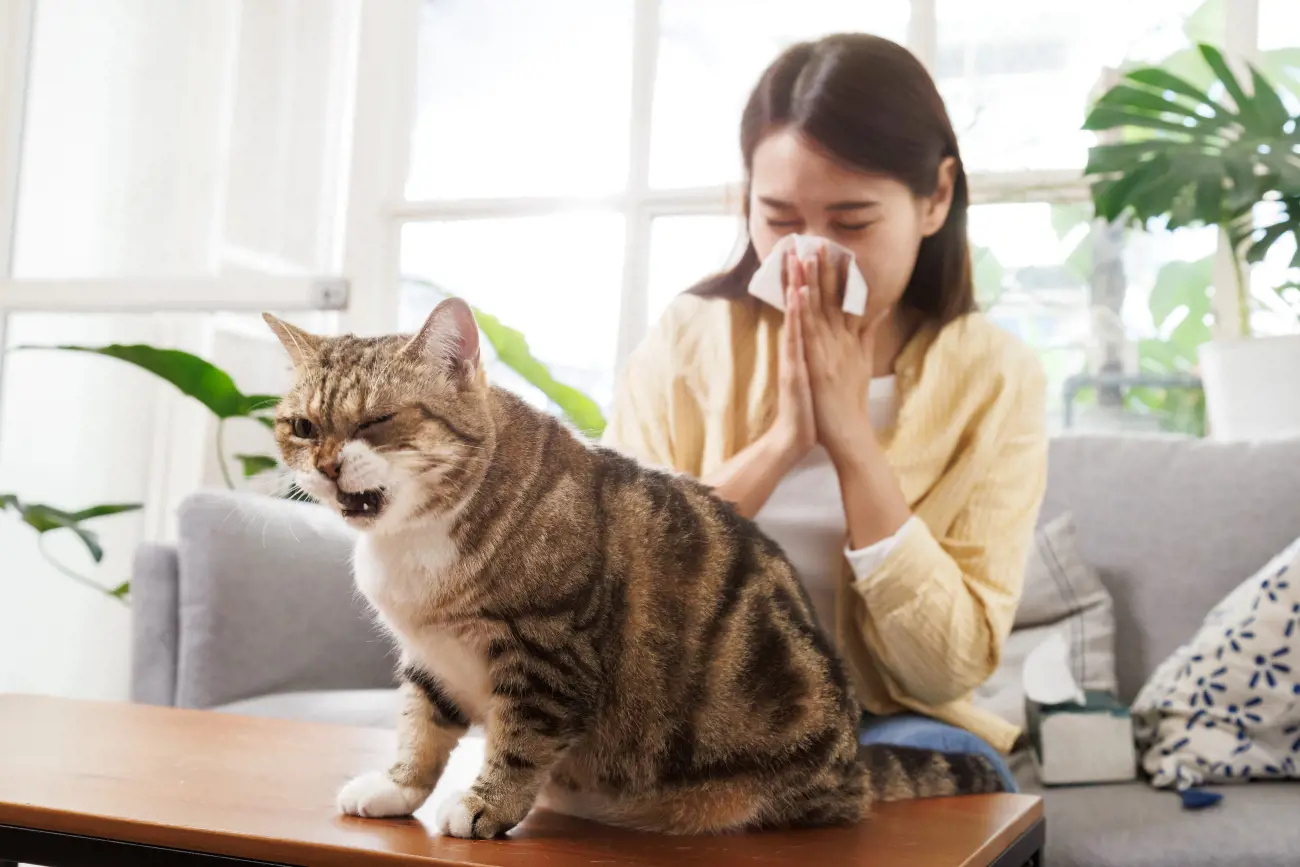Dog Bladder Infection - Causes, Symptoms, & What to do
29th August, 2024

Understanding Canine Urinary Tract Infections (UTIs)
The urinary tract means the kidneys, ureters, bladder and urethra. Urinary tract infections are common in dogs. They happen when invading bacteria, usually from the skin or gut, overcome the body’s defences and manage to start growing in places where they shouldn’t be. Cystitis or bladder infection is the most common type of UTI.
Causes of Bladder Infections in Dogs
Bacteria that come from the intestines can sometimes settle on the skin surrounding the anus, and from there they may find their way up the urethra and even into the bladder. The body has defences in place to expel these bacteria and prevent them from causing issues, but if these defences are overcome, a bladder infection will happen. Bacteria that normally live on the skin can sometimes cause issues as well. Escherichia coli is the most common bacteria causing UTI in dogs, being responsible for around half of all cases.
Female dogs are affected by bladder infections much more commonly than male dogs. In part this is due to the smaller distance between the digestive tract and the urethra, and in part it is due to the different structure of the urinary tract itself. The urethra is much shorter and wider in females, which makes it easier for bacteria to enter it and reach the bladder.
Some female dogs are also at higher risk because of a condition sometimes called vulvar fold dermatitis, where the shape of the skin around the vulva causes folds where bacteria can multiply, allowing them to invade the urethra from there. This condition is more common in some breeds, like bulldogs, and in overweight dogs.
Dogs that suffer from urinary incontinence are at higher risk for a bladder infection. Other conditions that affect the urinary tract or the immune system (for example bladder stones, Cushing’s disease or diabetes) may also make UTIs more likely.
Identifying Bladder Infection Symptoms in Dogs
Common symptoms of bladder infections in dogs:
- Peeing more frequently, often smaller amounts
- Peeing in the house, where this is out of character
- Taking longer to pass urine
- Abnormal appearance of urine: cloudy, unusual colour, blood-tinged
- Passing smelly urine: a fishy smell
- Pain when passing urine: whimpering or crying
- Becoming restless and finding it hard to settle
Diagnosing and Treating Bladder Infections
Bladder stones and non-bacterial cystitis will cause very similar symptoms to a UTI, so a urine analysis and culture is usually needed to confirm infection and helps select the best treatment. Other tests may also be needed to rule out or confirm an underlying cause, such as blood tests, ultrasound scans or x-rays.
If an established infection is confirmed, antibiotics will usually be required to treat it. Any underlying disease will also need to be controlled. Anti-inflammatory medications often help dogs feel more comfortable and may help the bladder heal.
Managing and Preventing Future Infections
Increasing urine flow by encouraging fluid intake may help clear the infection. This can be done by feeding wet food, adding water to dry food or offering ice cubes.
Some supplements containing glycosaminoglycans, proanthocyanidins (found in cranberry extracts) and D-mannose may play a role in making it more difficult for bacteria to settle in the urinary tract and cause damage.
There are no specific steps to prevent urinary tract infections, but many general health tips help:
- Keep your dog at a healthy weight.
- Feed a healthy, balanced diet suitable for your dog's age and lifestyle. Continue to use prescription diets if your vet advises this to prevent recurrence of a UTI.
- Ensure your dog gets lots of exercise and mental stimulation with safe toys and games.
- Encourage your dog to drink and ensure fresh water is always available.
- Clean under your dog’s tail if poo gets stuck in long hair or if your dog has very loose stools.
- Identify and treat other illnesses promptly.
Complications and When to Seek Help
If a bladder infection is left untreated, this can lead to a kidney infection. This is more serious as it can lead to kidney failure, which quickly becomes life-threatening. Untreated bladder infections may also allow bacteria to get into the blood and travel to other organs or cause a serious blood infection.
Find your nearest vet practice if your dog is:
- In shock or collapsed.
- Vomiting, drooling excessively or very lethargic.
- Unable to pass any urine.
- Shaking and very hot or very cold to touch.
- Developing severe and worsening symptoms, despite vet treatments for cystitis.
Cat Bladder Infection
What is Feline Lower Urinary Tract Disease (FLUTD)?
The term “Feline lower urinary tract disease” describes diseases affecting the urinary bladder and the urethra. The most common cause of feline lower urinary tract disease is Feline Idiopathic Cystitis, which is thought to be caused mostly by stress and lifestyle factors.
Other common causes are crystals in the urine (urolithiasis) and infections. Many cats will have repeated episodes throughout their life. These are very common and painful illnesses, and life-threatening complications may develop quickly, such as a urinary blockage.
Causes and Risk Factors of Feline Lower Urinary Tract Disease
The cause of an episode of Feline lower urinary tract disease will depend on the process involved:
- The current understanding points to Feline Idiopathic Cystitis being a chronic stress problem that disrupts the bladder function, similar to Interstitial cystitis in people. Stress will change multiple processes in the brain and also affect hormone levels in the body. In feline idiopathic cystitis, the normal bladder wall structure will change and protective mechanisms will be disrupted. This causes bouts of inflammation and pain in the bladder or urethra (the tube that communicates with the outside). Most cats will have several episodes during their life, with some having them very frequently. In severe episodes, secretions and swelling may physically block the passage of urine and lead to a life-threatening emergency.
- Urolithiasis is the formation of hard rock-like material from minerals in urine. These minerals originally come from the food. Normal urine contains minerals, including calcium, phosphorus, magnesium, chloride and sodium. Various factors can trigger increased crystal formation (Diet, stress, infection, lack of exercise, not drinking enough water, genetics, other diseases). Crystals may irritate the bladder wall, making it release thick mucus for protection. The mucus and crystals stick together, getting bigger and harder over time to form stones.
- In lower urinary tract infections, bacteria on the skin enter the vulva of female cats or the penis of males. These bacteria overcome the body's defences to invade the bladder wall. Infection causes inflammation and weakening of the bladder's protective layers, and symptoms develop due to pain, inflammation, bleeding and infection. Infections are much more common if other diseases are also present, such as diabetes or urinary incontinence.
These conditions share many risk factors and cause similar symptoms, and can also lead to each other.
If these conditions cause the flow of urine to be greatly reduced or stop, this is very painful and quickly leads to kidney damage and life-threatening complications. This is usually referred to as a urinary blockage. Emergency care is essential.
Symptoms of Feline Lower Urinary Tract Disease
Common signs of feline lower urinary tract disease include:
- Straining to pee
- Blood in the urine
- Peeing small amounts but very frequently
- Urinating outside of the litter tray or in abnormal places, like the shower
- Being in a rush to pee
- Being unable to pass any urine
- Tummy pain
Diagnosing Feline Urinary Tract Disease
The priority is to manage or prevent life-threatening complications, and this may require treatment to be started before a full diagnosis. The next step is to try to find all the factors contributing to the problem so they can be addressed. This may imply:
- Urine analysis, including culture to check for infections. Many urinary tract infections are caused by difficult to treat bacteria that may take a long time to eliminate. Knowing at the start what the bacteria is and what antibiotics are more likely to be effective improves response to treatment and reduces complications
- X-rays and/or ultrasound scans to check for masses, stones and crystals
- Nutritional assessment to check for imbalances
- Thorough behavioural assessment to check for signs of stress
Chronic pain can be a significant cause of stress, and further investigations may be needed to rule this out, especially in older cats or those with other health problems.
Treatment and Management of Urinary Tract Infections
- Urinary blockages are life-threatening emergencies and need to be treated straight away. This implies passing a urinary catheter under anaesthesia to restore the flow of urine. If this is not possible, the bladder may need to be emptied through a needle, and surgery to remove or bypass the blockage may be required
- Lower urinary tract disease can be very painful, this adds stress and can also cause further changes in the bladder and urethra. Treating the pain and inflammation is fundamental
- If an infection is present, antibiotics will be required
- Large bladder stones and stones made of Oxalate (the most common type) are removed with surgery
- Small stones and crystals that are made of struvite (the second most common type) may sometimes be dissolved with specific diets
- In cases of idiopathic cystitis that are not improving, medication to reduce anxiety or antidepressants may be used for a time to help manage stress and introduce a long-term management plan.
- Other medications, such as smooth muscle relaxants, may also be recommended in specific situations.
Prevention and Recovery
Some lifestyle changes will help during treatment and also reduce the frequency of further episodes:
- Stress management strategies help in most situations and especially with Feline idiopathic cystitis. These may include:
- Identifying and managing any possible causes of stress, such as competition with other cats, frustration, boredom, lack of socialisation, lack of control or lack of a feeling of safety.
- Pheromone products are often helpful in creating the feeling of safety and control.
- Paying extra attention to the litter box. Always make sure there is one more litter box than there are cats, try offering different types/litters/locations. The litter boxes should be scooped at least once per day.
- Environmental enrichment activities, such as puzzle feeding, hunting-like play and opportunities to climb and explore can be particularly helpful for indoor cats.
- Specific diets can treat struvite stones and crystals and help manage the symptoms of other types of stones as well.
- Increasing water intake and urine production often helps reduce symptoms and prevent complications. This can be achieved by making sure they have their preferred drinking methods available, and many urinary diets are designed to encourage greater water intake as well. Offering more wet food may also help, but if your cat prefers dry, other approaches are better.
- Supplements may be helpful, although there isn’t a lot of scientific evidence to confirm this at this stage. Products containing the following are frequently recommended:
- Glycosaminoglycans, which are building blocks for the protective layer that lines the inside of the bladder and seem to be deficient in cats with this disease. These are available in capsules and are also added to many urinary diets.
- Amino acids that are used to produce relaxing neurotransmitters in the brain, such as tryptophan.
- Casein is a protein that is thought to help reduce short-term stress in cats and is available as a supplement as well.
Stress and diet management in cats is often complex and very specific to each cat. Please don’t hesitate to ask your vet for further advice.
Many cats will suffer multiple episodes of lower urinary tract disease during their life, but following the strategies above will make these less common and less severe.
Common Questions and Concerns
Can cats get urinary tract infections from a dirty litter box?
Cats are usually very particular about their personal hygiene and are unlikely to contaminate themselves when using a dirty litter box. However, if the litter box is dirty they are likely to hold the urine in and urinate less frequently, which does greatly increase the risk of developing all of the different types of lower urinary tract disease.
How long can a cat with lower urinary tract disease go untreated?
Many cats have chronic urinary tract infections that cause little to no symptoms and go undiagnosed, especially older cats or those that suffer from diabetes. However, the longer the disease is present for, the more damage is done to the bladder and urethra. This is also true for non-infectious causes. Additionally, the amount of damage is usually proportional to the severity of the symptoms.
Worse symptoms mean more damage and higher risk for complications, making treatment more urgent. If a urinary blockage is suspected (no urine is being passed, pain is significant or your cat is becoming lethargic) this is a life-threatening condition and treatment needs to be started as soon as possible.
Helpful Pages
Recent Posts

Why do Great Danes bury their heads?
12/03/25
Find out more about Beagles
28/02/25Pet Insurance Quote
- 98% claims paid *
- Claims paid directly to vets
- 24/7 vet video consultations
- Interest free monthly payments


